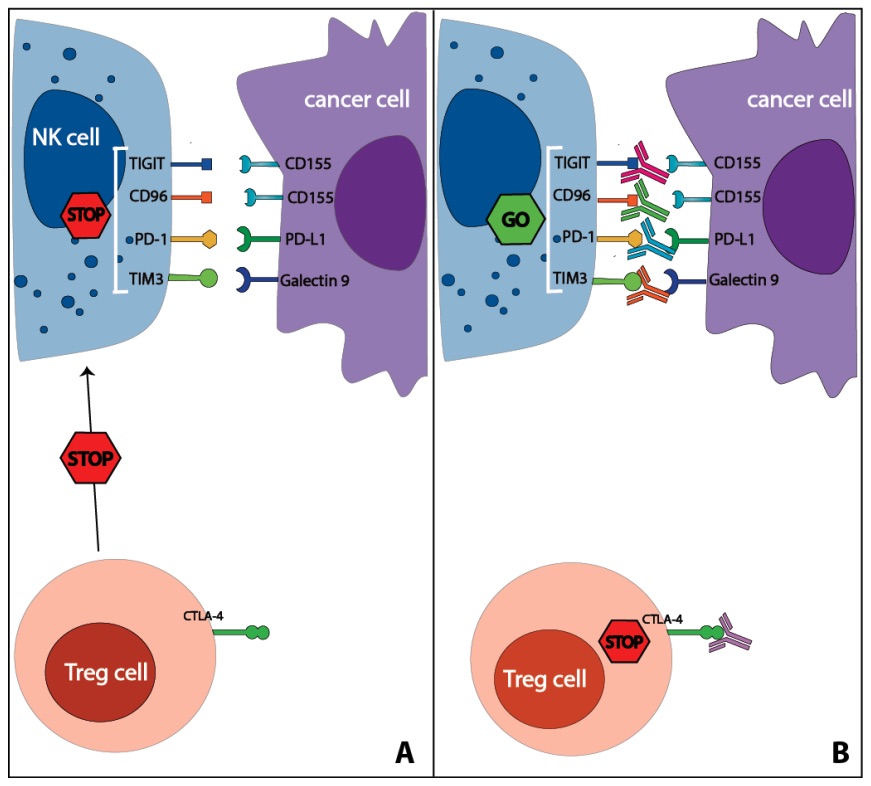Hi-Affi™ hPD-1/hPD-L1/hTIGIT Triple Humanized Mouse Model
Except for the most well-known immune checkpoints, PD-1 and PD-L1, TIGIT is another novel immunosuppressive receptor on immune cells. Targeting the TIGIT could also relieve the immunosuppression by tumor cells. Thus, the combination of anti-PD-1, anti-PD-L1, and anti-TIGIT antibodies is a new strategy for enhancing the anti-tumor immunity. Creative Biolabs has successfully established an optimized Hi-Affi™ “humanized” animal platform to offer specialty manipulated hPD-1/hPD-L1/hTIGIT triple humanized mice for our clients all over the world.
hPD-1/hPD-L1/hTIGIT Molecule
Human programmed cell death protein-1 (hPD-1) and human programmed cell death ligand -1 (hPD-L1) mediate the classic pathway inhibiting the effector T cell function. This pathway is important for immune tolerance, preventing autoimmune diseases. However, it is utilized by tumor cells to escape the attack from immune cells.
Human TIGIT (hTIGIT) has other names such as WUCAM, Vstm3, and VSIG9. It is a member of the poliovirus receptor (PVR)/Nectin family. It consists of an extracellular immunoglobulin variable region (IgV) domain, a type 1 transmembrane domain, and an intracellular domain. The intracellular domain contains a classic immunoreceptor tyrosine inhibition motif (ITIM) and an immunoglobulin tyrosine tail motif (ITTM). hTIGIT is expressed in lymphocytes, especially in effector and regulatory CD4+ T cells, follicular helper CD4+ T cells, effector CD8+ T cells, and natural killer cells (NKs).
 Fig. 1 Effects of immune checkpoint inhibitor therapies on NK cells.1
Fig. 1 Effects of immune checkpoint inhibitor therapies on NK cells.1
hPD-1/hPD-L1/hTIGIT Signal Pathway
The large amount of hPD-L1 expression in tumor tissues suggests that the hPD-1/hPD-L1 signaling pathway plays an important role in the negotiable tumor response. Many tumor cell lines can express hPD-L1 on their surface or highly express hPD-L1 under the induction of IFN-γ. hPD-L1 interacts with its receptor hPD-1, resulting in tumor antigen-specific T cell apoptosis, allowing tumor cells to escape body immunity monitor.
hTIGIT can suppress immune cells in multiple steps of the tumor immune cycle: STEP1. hTIGIT can inhibit NKs effects by preventing the initial death of tumor cells and releasing tumor antigens; STEP2. hTIGIT inhibits the ability of dendritic cells (DCs) to co-stimulate, resulting in decreased presentation of cancer antigens and increased anti-inflammatory cytokines such as IL-10. TIGIT can also induce PVR signaling in tumor cells; STEP3. Myeloid cells stimulated by hTIGIT+ regulatory T cells (Tregs) or PVR can inhibit the effect of CD8+ T cells or skew the polarization of CD4+ T cells; STEP4. hTIGIT can directly inhibit the effect of CD8+ T cells, or hTIGIT+ Tregs can inhibit CD8+ T cells and prevent the removal of cancer cells.
Development of hPD-1/hPD-L1/hTIGIT Triple Humanized Mice
hTIGIT is a newly discovered receptor on immune cells regulating the activation of immune responses. It facilitates the immune evasion of tumor cells, just like other immune checkpoints such as hPD-1 and hPD-L1. Blocking these down-regulatory molecules could activate the host immunity against the tumor cells. Thus, the combinational use of anti-hPD-1 antibody, anti-hPD-L1 antibody, and anti-hTIGIT antibody could be a promising therapy for cancer patients. Creative Biolabs is a professional CRO company with many years of experience and has been recognized by our global clients. We provide not only the Hi-Affi™ “humanized” animal models, but also related analysis services, to advance your preclinical drug development. If you have any questions about our humanized mice, please feel free to contact us for more details.
Creative Biolabs also offers other various Humanized Mouse Models you may be interested in:
Reference
- Toffoli, Elisa C., et al. "Natural killer cells and anti-cancer therapies: reciprocal effects on immune function and therapeutic response." Cancers 13.4 (2021): 711. Distributed under Open Access license CC BY 4.0, without modification.
For Research Use Only.
